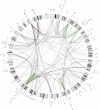Gene fusions in soft tissue tumors: Recurrent and overlapping pathogenetic themes
- PMID: 26684580
- PMCID: PMC5012284
- DOI: 10.1002/gcc.22335
Gene fusions in soft tissue tumors: Recurrent and overlapping pathogenetic themes
Abstract
Gene fusions have been described in approximately one-third of soft tissue tumors (STT); of the 142 different fusions that have been reported, more than half are recurrent in the same histologic subtype. These gene fusions constitute pivotal driver mutations, and detailed studies of their cellular effects have provided important knowledge about pathogenetic mechanisms in STT. Furthermore, most fusions are strongly associated with a particular histotype, serving as ideal molecular diagnostic markers. In recent years, it has also become apparent that some chimeric proteins, directly or indirectly, constitute excellent treatment targets, making the detection of gene fusions in STT ever more important. Indeed, pharmacological treatment of STT displaying fusions that activate protein kinases, such as ALK and ROS1, or growth factors, such as PDGFB, is already in clinical use. However, the vast majority (52/78) of recurrent gene fusions create structurally altered and/or deregulated transcription factors, and a small but growing subset develops through rearranged chromatin regulators. The present review provides an overview of the spectrum of currently recognized gene fusions in STT, and, on the basis of the protein class involved, the mechanisms by which they exert their oncogenic effect are discussed.
© 2015 Wiley Periodicals, Inc.
Figures


References
-
- Alaggio R, Zhang L, Sung Y-S, Huang S-C, Chen C-L, Bisogno G, Zin A, Agaram NP, LaQuaglia MP, Wexler LH, Antonescu CR. A molecular study of pediatric spindle and sclerosing rhabdomyosarcoma: Identification of novel and recurrent VGLL2-related fusions in infantile cases. Am J Surg Pathol. (in press) - PMC - PubMed
-
- Antonescu CR, Dal Cin P. Promiscuous genes involved in recurrent chromosomal translocations in soft tissue tumours. Pathol. 2014;46:105–112. - PubMed
-
- Antonescu CR, Nafa K, Segal NH, Dal Cin P, Ladanyi M. EWS-CREB1: A recurrent variant fusion in clear cell sarcoma—Association with gastrointestinal location and absence of melanocytic differentiation. Clin Cancer Res. 2006;12:5356–5362. - PubMed
Publication types
MeSH terms
Grants and funding
LinkOut - more resources
Full Text Sources
Other Literature Sources

